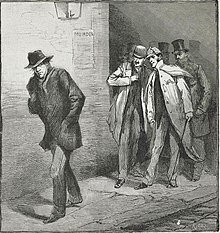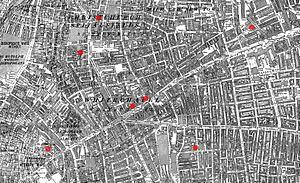Attacks ascribed to the Ripper typically involved female prostitutes from the slums whose throats were cut prior to abdominal mutilations. The removal of internal organs from at least three of the victims led to proposals that their killer possessed anatomical or surgical knowledge. Rumours that the murders were connected intensified in September and October 1888, and letters from a writer or writers purporting to be the murderer were received by media outlets and Scotland Yard. The "From Hell" letter, received by George Lusk of the Whitechapel Vigilance Committee, included half of a preserved human kidney, supposedly from one of the victims. Mainly because of the extraordinarily brutal character of the murders, and because of media treatment of the events, the public came increasingly to believe in a single serial killer known as "Jack the Ripper".
Extensive newspaper coverage bestowed widespread and enduring international notoriety on the Ripper. An investigation into a series of brutal killings in Whitechapel up to 1891 was unable to connect all the killings conclusively to the murders of 1888, but the legend of Jack the Ripper solidified. As the murders were never solved, the legends surrounding them became a combination of genuine historical research, folklore, and pseudohistory. The term "ripperology" was coined to describe the study and analysis of the Ripper cases. There are now over one hundred theories about the Ripper's identity, and the murders have inspired multiple works of fiction.
Background
In the mid-19th century, England experienced an influx of Irish immigrants, who swelled the populations of England's major cities, including the East End of London. From 1882, Jewish refugees from Eastern Europe and Tsarist Russia moved into the same area. The civil parish of Whitechapel in London's East End became increasingly overcrowded. Work and housing conditions worsened, and a significant economic underclass developed. Robbery, violence and alcohol dependency were commonplace, and the endemic poverty drove many women to prostitution. In October 1888, London's Metropolitan Police Service estimated that there were 1200 prostitutes and about 62 brothels in Whitechapel. The economic problems were accompanied by a steady rise in social tensions. Between 1886 and 1889, frequent demonstrations, such as that of 13 November 1887, led to police intervention and further public unrest. Racism, crime, social disturbance, and real deprivation fed public perceptions that Whitechapel was a notorious den of immorality. In 1888, such perceptions were strengthened when a series of vicious and grotesque murders attributed to "Jack the Ripper" received unprecedented coverage in the media.Murders
Whitechapel murders
The large number of attacks against women in the East End during this era adds uncertainty to how many victims were killed by the same person. Eleven separate murders, stretching from 3 April 1888 to 13 February 1891, were included in a London Metropolitan Police Service investigation, and were known collectively in the police docket as the "Whitechapel murders". Opinions vary as to whether these murders should be linked to the same culprit or not, but five of the eleven Whitechapel murders, known as the "canonical five", are widely believed to be the work of the Ripper. Most experts point to deep throat slashes, abdominal and genital-area mutilation, removal of internal organs, and progressive facial mutilations as the distinctive features of Jack the Ripper's modus operandi. The first two cases in the Whitechapel murders file, those of Emma Elizabeth Smith and Martha Tabram, are not included in the canonical five.
Smith was robbed and sexually assaulted on Osborn Street, Whitechapel, on 3 April 1888. A blunt object was inserted into her vagina, which ruptured her peritoneum. She developed peritonitis, and died the following day at London Hospital. She said that she had been attacked by two or three men, one of whom was a teenager. The attack was linked to the later murders by the press, but most authors conclude that it was gang violence unrelated to the Ripper case.
Tabram was killed on 7 August 1888; she had suffered 39 stab wounds. The savagery of the murder, the lack of obvious motive, and the closeness of the location (George Yard, Whitechapel) and date to those of the later Ripper murders led police to link them. However, the attack differs from the canonical ones in that Tabram was stabbed rather than slashed at the throat and abdomen. Many experts today do not connect it with the later murders because of the difference in the wound pattern.


No comments:
Post a Comment